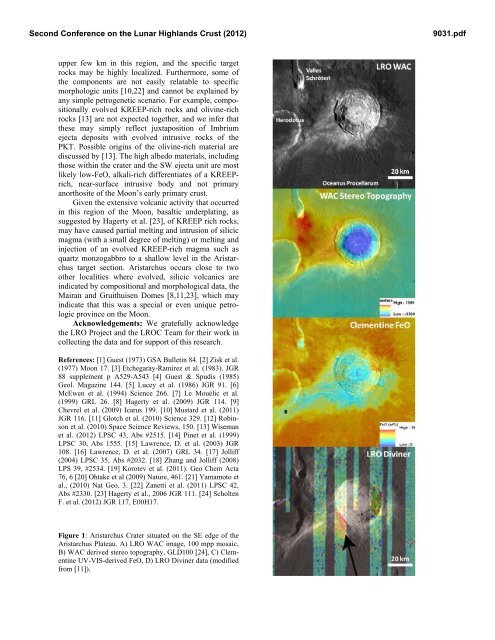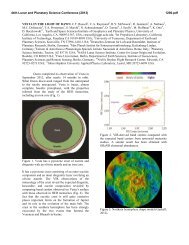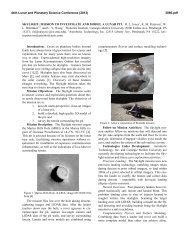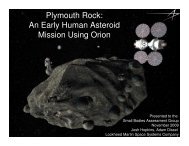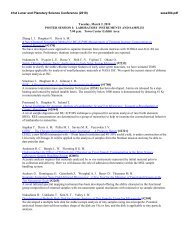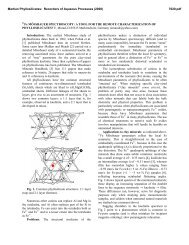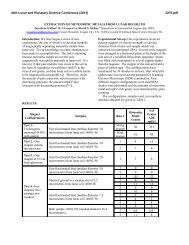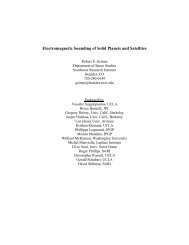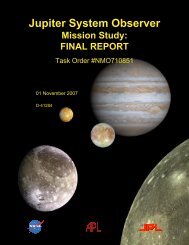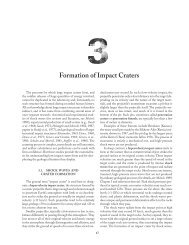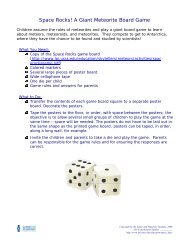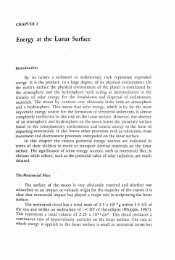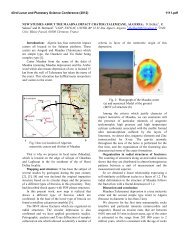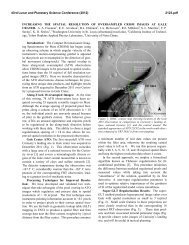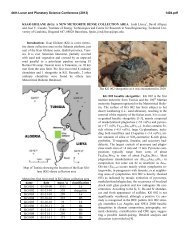Aristarchus Crater as a Probe of the Lunar Crust's Most Fractionated ...
Aristarchus Crater as a Probe of the Lunar Crust's Most Fractionated ...
Aristarchus Crater as a Probe of the Lunar Crust's Most Fractionated ...
You also want an ePaper? Increase the reach of your titles
YUMPU automatically turns print PDFs into web optimized ePapers that Google loves.
Second Conference on <strong>the</strong> <strong>Lunar</strong> Highlands Crust (2012)<br />
upper few km in this region, and <strong>the</strong> specific target<br />
rocks may be highly localized. Fur<strong>the</strong>rmore, some <strong>of</strong><br />
<strong>the</strong> components are not e<strong>as</strong>ily relatable to specific<br />
morphologic units [10,22] and cannot be explained by<br />
any simple petrogenetic scenario. For example, compositionally<br />
evolved KREEP-rich rocks and olivine-rich<br />
rocks [13] are not expected toge<strong>the</strong>r, and we infer that<br />
<strong>the</strong>se may simply reflect juxtaposition <strong>of</strong> Imbrium<br />
ejecta deposits with evolved intrusive rocks <strong>of</strong> <strong>the</strong><br />
PKT. Possible origins <strong>of</strong> <strong>the</strong> olivine-rich material are<br />
discussed by [13]. The high albedo materials, including<br />
those within <strong>the</strong> crater and <strong>the</strong> SW ejecta unit are most<br />
likely low-FeO, alkali-rich differentiates <strong>of</strong> a KREEPrich,<br />
near-surface intrusive body and not primary<br />
anorthosite <strong>of</strong> <strong>the</strong> Moon’s early primary crust.<br />
Given <strong>the</strong> extensive volcanic activity that occurred<br />
in this region <strong>of</strong> <strong>the</strong> Moon, b<strong>as</strong>altic underplating, <strong>as</strong><br />
suggested by Hagerty et al. [23], <strong>of</strong> KREEP rich rocks,<br />
may have caused partial melting and intrusion <strong>of</strong> silicic<br />
magma (with a small degree <strong>of</strong> melting) or melting and<br />
injection <strong>of</strong> an evolved KREEP-rich magma such <strong>as</strong><br />
quartz monzogabbro to a shallow level in <strong>the</strong> <strong>Aristarchus</strong><br />
target section. <strong>Aristarchus</strong> occurs close to two<br />
o<strong>the</strong>r localities where evolved, silicic volcanics are<br />
indicated by compositional and morphological data, <strong>the</strong><br />
Mairan and Gruithuisen Domes [8,11,23], which may<br />
indicate that this w<strong>as</strong> a special or even unique petrologic<br />
province on <strong>the</strong> Moon.<br />
Acknowledgements: We gratefully acknowledge<br />
<strong>the</strong> LRO Project and <strong>the</strong> LROC Team for <strong>the</strong>ir work in<br />
collecting <strong>the</strong> data and for support <strong>of</strong> this research.<br />
References: [1] Guest (1973) GSA Bulletin 84. [2] Zisk et al.<br />
(1977) Moon 17. [3] Etchegaray-Ramirez et al. (1983). JGR<br />
88 supplement p A529-A543 [4] Guest & Spudis (1985)<br />
Geol. Magazine 144. [5] Lucey et al. (1986) JGR 91. [6]<br />
McEwen et al. (1994) Science 266. [7] Le Mouélic et al.<br />
(1999) GRL 26. [8] Hagerty et al. (2009) JGR 114. [9]<br />
Chevrel et al. (2009) Icarus 199. [10] Mustard et al. (2011)<br />
JGR 116. [11] Glotch et al. (2010) Science 329. [12] Robinson<br />
et al. (2010) Space Science Reviews, 150. [13] Wiseman<br />
et al. (2012) LPSC 43, Abs #2515. [14] Pinet et al. (1999)<br />
LPSC 30, Abs 1555. [15] Lawrence, D. et al. (2003) JGR<br />
108. [16] Lawrence, D. et al. (2007) GRL 34. [17] Jolliff<br />
(2004) LPSC 35, Abs #2032. [18] Zhang and Jolliff (2008)<br />
LPS 39, #2534. [19] Korotev et al. (2011). Geo Chem Acta<br />
76, 6 [20] Ohtake et al (2009) Nature, 461. [21] Yamamoto et<br />
al., (2010) Nat Geo, 3. [22] Zanetti et al. (2011) LPSC 42,<br />
Abs #2330. [23] Hagerty et al., 2006 JGR 111. [24] Scholten<br />
F. et al. (2012) JGR 117, E00H17.<br />
Figure 1: <strong>Aristarchus</strong> <strong>Crater</strong> situated on <strong>the</strong> SE edge <strong>of</strong> <strong>the</strong><br />
<strong>Aristarchus</strong> Plateau. A) LRO WAC image, 100 mpp mosaic,<br />
B) WAC derived stereo topography, GLD100 [24], C) Clementine<br />
UV-VIS-derived FeO, D) LRO Diviner data (modified<br />
from [11]).<br />
9031.pdf


